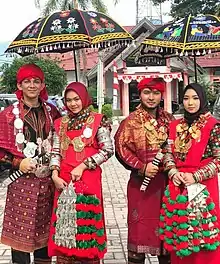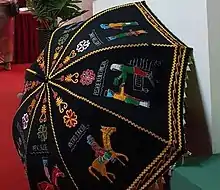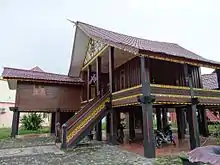 The Alas people on 29 June 1904 in front of Gotfried Coenraad Ernst van Daalen (Photographed by Henricus Marinus Neeb) | |
| Total population | |
|---|---|
| 93,000[1] | |
| Regions with significant populations | |
| Languages | |
| Alas and Indonesian | |
| Religion | |
| Islam | |
| Related ethnic groups | |
| Kluet people, Singkil people, Karo people |
The Alas people is an indigenous ethnic group from Kutacane, Southeast Aceh district, Sumatra, Indonesia. The Alas are found in the Gunung Leuser, Ketambe, and Alas River areas.
Society


The Alas (ukhang Alas or kalak Alas) are an agrarian people, who cultivate rice on irrigated fields, but some grow cash crops in gardens. Freshwater fishing in Alas River or brooks used to be indispensable as a source of animal protein, while raising fish in ponds is becoming important. Between the 15th and 17th centuries, they converted to Islam, The Alas society is a patrilineal descent society; each belongs to one exogamous clan. Sometimes an Alas village (kute) consists of a single clan, while several clans could frequently be observed in one village.[2] As Alas clan names suggest, the Alas people have composite origins.
Van Daalen's Alas, Batak and Gayo campaign
At the final stage of the Aceh War in 1904, Gotfried Coenraad Ernst van Daalen started on his campaign to Gayoland, Alasland, and Batakland in order to establish the Dutch colonial control over them. After demolishing 7 forts and killing nearly 1300 inhabitants in Gayoland, his Korps Marechaussee te voet appeared in the Alas valley on 10 June 1904. One local lord (kejukhun) at northern Alasland surrendered immediately, but, as the other local lord of Gayonese descent at southern Alasland had already been killed in Gayoland by Gotfried Coenraad Ernst van Daalen, his son, the acting southern local lord, and a brother of the northern local lord decided to confront the non-Islamic Dutch, building 3 forts or fortified villages.
On 14 June 1904, the Dutch troops demolished the fort of Kuta Reh, killing 313 indigenous men, 189 women, and 59 children, while 2 Dutch soldiers were killed. On 20 June 1904, then, they demolished the fort of Likat, killing 220 men, 124 women, and 88 children, while a single soldier was killed. Indeed, the village of Likat was one of Gayonese migrants into the Alas valley. On 24 June 1904, finally, they demolished the fort of Kute Lengat Baru, killing 338 men, 186 women, and 130 children, including the acting southern local lord, while 3 soldiers were killed. On 29 June 1904, Gotfried Coenraad Ernst van Daalen summoned the northern local lord and the son of the deceased southern local lord with all other Alas chiefs and headmen to the village of Pedesi in front of him, to declare that the whole of Alasland belonged to the Dutch East Indies.
During this campaign, Henricus Marinus Neeb, a military doctor, took many photos, including ones of fighting scenes, marching through the tropical rain forest, local fishing activities, traditional houses, mosques, and so on.[3]
Language

The Alas people uses the Alas language (Cekhok Alas) on a daily basis. The Alas language is most closely related to the language of the Kluet people in Aceh Selatan Regency,[4] and often, these two languages are unified under a single label Alas–Kluet. Together with Karo and Dairi, Alas–Kluet belongs to the northern branch of the Batak subgroup of the Austronesian language family.[5] It is estimated that 80,000 people spoke the language in 2000.[6] Although Alas people live in Aceh Province, the language they use is entirely distinct from Acehnese.
Clans

Each Alas person belongs to a patrilineal clan or descent group (mekhge). It has its own name, which is used as surname of the Alas people.[7] In 1988 there were 27 clans as follows, but some had already had no member. Out of them, 8 clans, viz. Bangko, Cibekho, Deski, Keling, Kepale Dese, Kekhuas, Pagan, and Selian, are believed to be original among the Alas.
- Bangko
- Deski
- Keling
- Kepale Dese
- Kekhuas
- Pagan
- Selian
- Acih
- Bekhuh
- Gale
- Kekakho
- Mahe
- Menalu
- Mencawan (Bencawan)
- Munte
- Pase
- Pelis
- Pinim
- Ramin
- Ramud
- Sambo
- Sekedang
- Sugihen
- Sepayung
- Tekhigan
- Cibekho
- Sinage
Arts

Alas traditional dances[8] and musical instruments[9] are as follows:
Crafts

Alas traditional crafts are as follows:
- Nemet (weaving of rumbia leaves)
- Mbayu amak (pandan mat)
- Bordikh (customary attire)
- Pisau bekhemu (Alas traditional sword)
- Payung mesikhat (Alas ritual umbrella)
Traditional dishes
Alas traditional dishes are as follows:[11]
- Manuk labakh
- Ikan labakh
- Puket megaukh
- Lepat bekhas
- Gelame
- Puket megaluh
- Buah khum-khum
- Ikan pacik kule
- Telukh mandi
- Puket mekuah
- Tumpi
- Godekhr
- Puket sekuning
- Cimpe
- Getuk
References
- ↑ "Alas in Indonesia". Joshua Project. Retrieved 2014-11-02.
- 1 2 Akifumi Iwabuchi (1994). The People of the Alas Valley: A Study of an Ethnic Group of Northern Sumatra. Clarendon Press. ISBN 0-19-827902-7.
- ↑ Kempees, J. C. J. (1905). De tocht van Overste van Daalen door de Gajō-, Alas- en Bataklanden, 8 februari tot 23 juli 1904. J. C. Dalmeijer.
- ↑ John Fitzgerald McCarthy (2006). The Fourth Circle: A Political Ecology of Sumatra's Rainforest Frontier. Stanford University Press. ISBN 08-047-5212-5.
- ↑ Alexander Adelaar and Nikolaus Himmelmann (2013). The Austronesian Languages of Asia and Madagascar. Routledge. ISBN 978-11-367-5509-5.
- ↑ "Batak Alas-Kluet". Ethnologue. Retrieved 2017-02-25.
- ↑ Thalib Akbar (2004). Sanksi dan Denda Tindak Pidana Adat Alas. Majelis Adat Aceh Tenggara.
- ↑ Tim Penyusun Musyawarah Adat Alas dan Gayo (2003). Komisi: A (Adat Alas). Pemerintah Kabupaten Aceh Tenggara.
- ↑ Zulyani Hidayah (1997). Ensiklopedi: Suku bangsa di Indonesia. Pustaka LP3ES. ISBN 979-8391-64-0.
- ↑ Bakhrum Yunus (1987). Struktur sastra lisan Alas. Pusat Pembinaan dan Pengembangan Bahasa, Departemen Pendidikan dan Kebudayaan. OCLC 20579319.
- ↑ Makarina Rina. "Makanan Khas Suku Alas". Google+. Retrieved 2014-12-12.
Further reading
- Akifumi Iwabuchi, 1994, The People of the Alas Valley: A Study of an Ethnic Group of Northern Sumatra, Oxford: Clarendon Press, ISBN 0-19-827902-7.